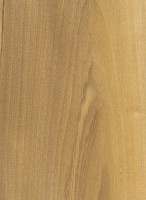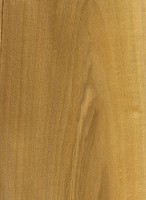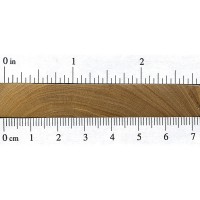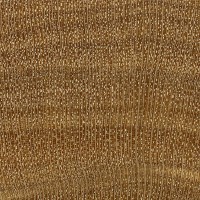 |
Common Name(s): Lancewood, West Indian Lancewood Scientific Name: Oxandra lanceolata (syn. Uvaria lanceolata) Distribution: Primarily the Caribbean, though present in Central and South America as well Tree Size: 50 ft (15 m) tall, 1-1.5 ft (.3-.5 m) trunk diameter Average Dried Weight: 61 lbs/ft3 (980 kg/m3) Specific Gravity (Basic, 12% MC): .81, .98 Janka Hardness: 2,830 lbf (12,590 N) Modulus of Rupture: 23,700 lbf/in2 (163.5 MPa) Elastic Modulus: 2,900,000 lbf/in2 (20.00 GPa) Crushing Strength: No data available Shrinkage: Radial: 6.2%, Tangential: 9.6%, Volumetric: 15.4%, T/R Ratio: 1.5 |
Color/Appearance: Lancewood that is harvested commercially generally consists of sapwood rather than heartwood, which is a pale yellow color. Older trees with heartwood tend to be less desirable than younger trees. Heartwood is a darker golden yellow, sometimes with hues of green or gray. Medium to large medullary rays also give this wood a decent amount of ray fleck on quartersawn surfaces.
Grain/Texture: Grain is straight, with a very fine and even texture and a natural luster.
Endgrain: Diffuse-porous; small to medium pores in no specific arrangement, moderately numerous to numerous; commonly in radial multiples of 2-4; growth rings indistinct; large rays visible without lens, spacing normal; parenchyma diffuse-in-aggregates, banded (reticulate).
Rot Resistance: Since primarily only sapwood is used, the wood is non-durable and susceptible to insect attack, though it has a high resistance to abrasion and wear.
Workability: Generally gives good results to most machining operations, though it has a high cutting resistance, so work may be slow. Lancewood also has a moderate blunting effect on cutting edges. Turns superbly.
Odor: No characteristic odor.
Allergies/Toxicity: Besides the standard health risks associated with any type of wood dust, no further health reactions have been associated with Lancewood. See the articles Wood Allergies and Toxicity and Wood Dust Safety for more information.
Pricing/Availability: Because of the tree’s small size, Lancewood usually only available in narrower boards and turning stock. It’s almost never seen for sale in the United States, though natural supplies are still ample. Prices are expected to be moderate for an imported wood.
Sustainability: This wood species is not listed in the CITES Appendices or on the IUCN Red List of Threatened Species.
Common Uses: Fishing rods, pool cues, archery bows, and turned objects.
Comments: It’s a shame that Lancewood isn’t more readily avaialable; it seems as though it’d make a perfect substitute for boxwood, especially in applications where strength is important.
Note that even though the sapwood of Lancewood is used most often, the heartwood is mildly fluorescent under a blacklight.
None available.








When’s the best time to harvest a lance wood tree